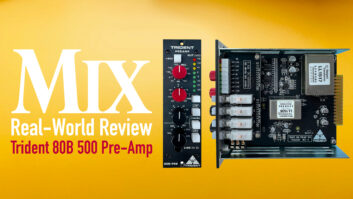
Ingram Engineering’s MPA685 dual-channel microphone preamp is a large, two-rackspace (14 inches deep) unit that’s handmade in the U.S. and features three switchable input-impedance choices and up to 76 dB of gain. Changing the input impedance presented to a microphone by the preamp alters the mic’s sound and operation. For the recording engineer, having this ability expands the range of sounds possible from any microphone.

You can order the retro-looking MPA685 in either of two impedance range options. Option 1 has 60, 200 and 600-ohm impedance choices for passive or active mics that sound best working into lower impedances. Option 2 (the unit reviewed here) has 600, 1.5k and 2.5k-ohm choices, and is better suited to condenser or ribbon mics that require higher impedances.
Input impedances are selectable using a front panel rotary switch that alters a switched resistor network on the secondary winding of a custom Sowter mic input transformer. This method “reflects” the impedance change back to the primary and provides the subsequent preamplifier section with a constant impedance load for good transient response, low noise, phase coherency and flat frequency response over a wide gain range.
Each channel of the MPA uses two Ingram-designed, J-FET-based, Class-A gain block stages, while a third module and an electronically balanced output buffer amp drives a Jensen output transformer. These three encapsulated modules use all-discrete components and the same pin-out and voltages as API’s 2520 and Jensen’s 990 modules.
A front panel 24-position Goldpoint rotary switch sets the gain of the second gain block to optimize its signal-to-noise, dynamic range and transient response predicated upon the mic’s output signal level. The knob’s “0” center position is unity, and rotating clockwise adds gain while turning the control counterclockwise attenuates gain. The front panel markings are for reference and do not indicate gain in dB.
There is 65 dB of gain adjustment in steps that are coarser (6.5 dB) at the low- and high-gain extremes and finer (2dB steps) in the more used, middle-gain range. The MPA also has a regulated +48-volt phantom-power on/off switch and a 1-megohm FET-buffered DI ¼-inch input with loop-through.
For each channel, there are front panel overload LEDs that light when 1-percent THD is reached. Another rotary switch selects the corner frequency for a 6dB/octave highpass filter. Choices include bypass, 70 Hz or 140 Hz. Finally, a continuously variable output gain control finely adjusts total gain.

Noise vs. Impedance with and without X-former
PREAMPS X3
The first test was a quick shootout to see where the MPA sits compared to other well-known mic pre’s. I built a special four-way mic splitter for the occasion using a Jensen JT-MB-E transformer.
My first A/B/C test compared the MPA to GML 8302 and Neve 1272 mic pre’s. I used a Royer 121 ribbon mic on a Fender Champ amp to record a clean electric guitar performance to Pro Tools|HD9 at 96 kHz. The MPA was set to high impedance (2.5k), the +6 gain position, with the output full up, while the GML and Neve were both set to 50 dB.
I found the MPA to have a lot of available gain, but at first it sounded thin compared the other preamps. Selecting the Ingram’s low-impedance (600-ohm) position changed that right away. The lower-impedance position required more gain up at the +9 position. Now the MPA sound stood right up and was clear, fat and present-sounding. The GML sounded as expected, very clean and clinical, while the Neve was warm, thick and a little dark compared to the others.
For loud crunch sounds, I changed guitar amps but kept the Royer. I was surprised to hear the MPA (still on low impedance) holding up perfectly with gain set down to +1 and sounding big, open, clear and loud. The GML, at 35dB gain, became slightly midrangy and “barky,” while the Neve, also at 35 dB, got “spongier”—softer sounding compared to the clean electric guitar tests. Unlike the GML or Neve pre’s, the MPA didn’t change in sound character with the increased input level.
MPA VOCALS
I took the MPA685 solo for a vocal session using my MXL Revelation tube mic set to cardioid. In general, compared to my other preamps, I found the MPA to be more transparent during peak level moments. One of these moments is just at the point where my loud singer hits his stride right up close to the mic. All preamps sound nasty when overloaded, but the MPA is more forgiving; it sounds better at those moments.
Switching impedances from high to medium to low steps the output level down, respectively. Depending on the mic, I found that I had to bump the gain up two to four clicks when switching to a lower-impedance setting to obtain the same recording level. The sound quality for the same mic is also different; the low-impedance setting, along with more mic gain, produces a warmer and more intimate sound.
Moving to medium seemed to change my singer’s mic presence very slightly, with a change in the mic’s LF character. Use the high-impedance position and the mic is loaded more like a typical bridging input of a modern mic pre.
Running five or more extras clicks of gain and winding back the output level will produce a “hotter” sound by way of a subtle increase in IM, and, as pleasant as this sounds sometimes, it is level-dependent and inconsistent.
ACOUSTIC GUITAR
I tried a stereo recording of a Martin D15 using a Rode NT4 X/Y stereo condenser. The two channels of the MPA matched exactly in level and sound. I swapped the L/R outs of the mic between channels to check this. This time, the tonal change between high and low impedance was subtle—just slightly warmer in low but more articulated sounding when using the high-impedance position; it just depends on what you’re looking for. For the song I was working on, I found the low impedance and about +3 to +5 on the gain rotary with the 70Hz HPF was best.
DI, TOO
I tried the MPA’s DI path and again found loads of gain. The front panel “chicken head” gain knob was now at the -7 position for a stock Fender Jazz bass with passive pickups. The sound was clear and precisely the way this bass sounds under ideal conditions. With this much gain available, guitars with low-output piezoelectric pickups would be no problem to amplify with this excellent-sounding DI.
REDISCOVER YOUR MIC COLLECTION
The MPA685 allows you to rediscover your whole mic collection by way of its three input impedance choices, remarkable dynamic range and its huge reservoir of gain. Add the super-DI path, and you have an excellent, professional and worthwhile tool ready for any recording task.
Barry Rudolph is an L.A.-based recording engineer.

Click on the Product Summary box above to view the MPA685 product page.







